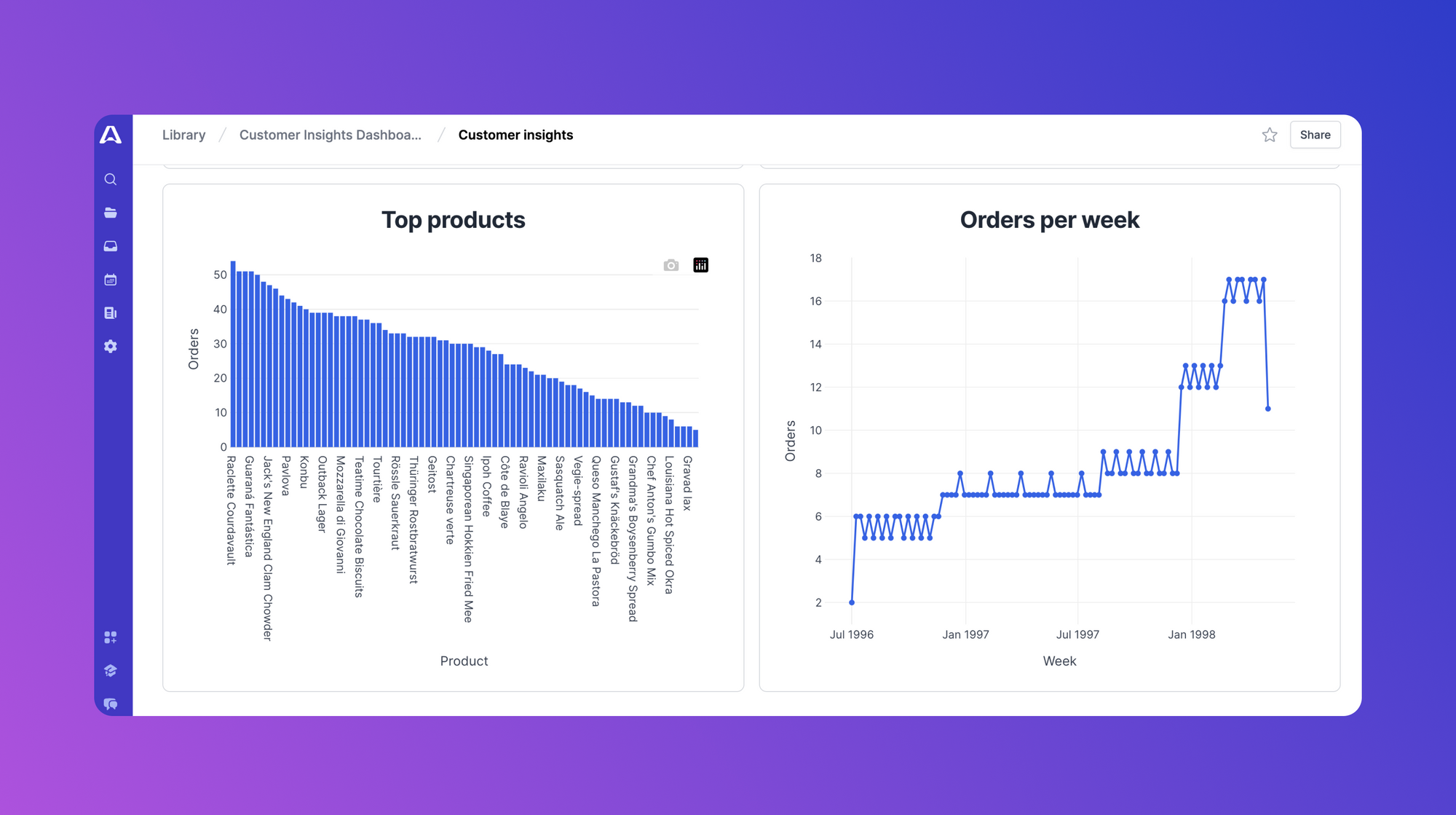When you decide to create a dashboard for your business, it's easy to get overwhelmed with the myriad of solutions available. Often, after looking at all the different SaaS products and tools available in the marketplace, a company will make the decision to instead build a dashboard solution in-house. This brings to light an important question: is it better to build your own dashboard solution or use an off-the-shelf software product to get what you need?
The answer is that it depends on your goals. In this article, we'll take a look at some of the pros and cons of building your own business dashboards vs buying and implementing an off-the-shelf dashboard product.
Benefits of building your own solution
While it can be tempting to think that buying and implementing an existing dashboard product might be the more straightforward way to accomplish your goals, building your own solution does have definite upsides.
Some of the greatest benefits of building your own solution are:
- Complete customizability
- Ability to prioritize bug fixes
- Competitive advantage in your industry
We cover these in greater detail below.
Complete customizability
When you take ownership over the entire product development process, all the decisions you've made about that product, all the code repositories involved, and the people who built the product are in-house. This makes it much easier to make decisions to customize the product you're building to fit your exact business needs.
If you start using your dashboard and realize that you need to be tracking different metrics or integrating a completely different data set, you have the developers who initially built the dashboard available to make changes quickly. With all the people and resources at your disposal to make necessary changes, this can make the difference between your dashboard being successful and being a failed launch of an internal project.
Ability to prioritize bug fixes
If you use an off-the-shelf product to implement dashboards in your business and you find a gap in the software or product you chose, your best option is to email support and report the problem. At that point, it's up to the development team to decide when (or if) your issue gets addressed, how it fits into their current product roadmap, and what that timeline might look like. If what you discovered is truly a roadblock to implementing this solution in your business and they decide not to prioritize it, you might be back to searching for a new solution.
On the other hand, if you developed this new dashboard in-house, you would have a lot more control over the cadence and priority of bug fixes, feature additions, and future improvements. You can adjust the roadmap as necessary to help support the business cases of the dashboard. This means you can be even more sure that the solution that's developed will be able to adjust to support the use cases it was designed for in the first place.
Competitive advantage in your industry
When you build your own tools in-house, you gain technology that your competitors don’t have. For example, if you build a dashboard with features not available as part of the existing 3rd-party solutions, you can use this new custom tool to help your business perform more effectively. Whether it allows your organization to cut costs, ship features faster or improve some other key metric, having this technological advantage could be key to helping your business get ahead, especially if most of your competitors are using the same tools.
Drawbacks to building your own solution
While there are benefits to building your own dashboards in-house, some drawbacks might make looking at 3rd-party solutions more attractive.
Some of the drawbacks to consider when building your own solution are:
- Longer time-to-market
- Fewer engineering resources available for your main product
- Increased maintenance costs
We cover these in greater detail below.
Longer time-to-market
Spinning up a product development cycle from scratch can take a long time. Especially if your existing team is focused on maintaining an existing product rather than creating a new one, putting together a team to build a brand-new product can be a challenge.
This is in sharp contrast to buying an existing solution, which you can begin implementing on day one. You can start using this off-the-shelf solution without worrying about design, the product development lifecycle, managing and prioritizing feature development and everything else that goes into creating a product from scratch.
Fewer engineering resources on the main product
If your engineering team is already busy working on your existing product, it can be difficult for them to find time to also work on this new dashboard product as well. When the business priority is your main product, projects like building a dashboard internally are constantly pushed to the back burner, which makes them drag on much longer than they were intended and, in many cases, turn into failed projects.
Increased maintenance costs
Even after the first version of your new dashboard has been developed, if you have built it in-house, you are also now responsible for all of the associated maintenance. This means, hosting the dashboard, making sure it's available, fixing any bugs, updating any of the underlying software, keeping it secure and much more. You have to make sure there are ongoing resources assigned to the project even after it's officially launched so that it can continue running smoothly.
Benefits of buying a solution
If you have decided that building your own dashboard isn't a good fit for you, there are definitely some benefits to using an existing solution:
- Lower initial implementation time
- A fixed, pre-determined cost
- Greater development focus on your core product
We cover these in greater detail below.
Lower initial implementation time
Because existing dashboard products are already built to support a wide variety of use cases, it's extremely likely that you'll be able to find one that supports what you're already looking for. This means you can start using this solution quickly with minimal configuration and start seeing results just as quickly.
Fixed, pre-determined cost
Whenever you take on a product development project internally, there's always some uncertainty about how much it's going to cost. On the other hand, when using a 3rd-party solution, you are quoted the entire cost up front. With a guarantee that no unexpected costs will arise, many budgeting discussions around the implementation of the project can go much more smoothly. process. Often, this is a reason that many internal projects never move forward, so it's an important aspect of any buy vs build decision.
Greater developer focus on your core product
As we discussed above, if you have to take engineering time and talent form the businesses core product to focus on building an internal dashboard, there are bound to be some inefficiencies.
For one, that means the business' core product doesn't have as much time and attention, which could have longer-term implications for this business as a whole. In addition, if an internal dashboard product isn't the sort of project that these repurposed developers normally work on, there will be some loss of efficiency as they learn and implement all the tools and processes they need to be successful, which will increase the overall timeline of the project.
By choosing a pre-built solution instead, you can allow the developers you would utilize for an in-house project to stay focused on the core product of the business while still realizing the benefits of a working dashboard product.
Drawbacks to buying a solution
Despite having more than a few benefits, buying and implementing a 3rd-party solution isn't always smooth sailing. Some of the drawbacks to using a 3rd-party tool are:
- Little to no influence on product direction
- Potentially no product that fits your needs
- Vendor lock-in
We cover these in greater detail below.
Little to no influence on product direction
Because you are just one customer of many, you may have input on new feature development and what gets prioritized, but ultimately you don't have control of the product direction. This means that if you find a feature gap as part of your implementation or a bug that is crucial to how you're going to use your new dashboard that the product team isn't going to prioritize, you're back at square one searching for a new solution.
Especially if you already have this dashboard implemented and working, this can be a very painful and time-consuming process.
Potentially no product that fits your needs
If you have a very specific use case or unconventional data or security requirements it's possible that your search for a 3rd-party solution will end with discovering that there's no product that fits your needs. This means you'll have to end up building your own solution anyway, after spending time in the searching for and evaluating all the various 3rd-party solutions.
Depending on how many different products you've evaluated and how in-depth each of these evaluation stages were, this could mean a lot of time wasted as part of this search process.
Vendor lock-in
Depending on what type of solution you choose, getting all your data prepared and imported might mean making vendor-specific decisions that will increase the difficulty of switching to another solution. If you eventually find out that the solution you selected isn’t going to work for you but you have already put a lot of work into building processes to fit that solution, you might be stuck with a less-than-ideal dashboard, simply because of the switching costs associated with choosing a new tool.
What about a hybrid solution?
Luckily, the buy vs build decision doesn't have to be completely binary. With a tool like Airplane, you can have the best of both worlds.
Airplane provides a powerful framework for creating internal tools like dashboards that give you all the benefits of a 3rd-party solution: a team dedicated to improving the product, pre-built tools such as frontend components and a fully working solution out of the box that allows you to get started quickly and have a working dashboard up and running in hours instead of weeks.
Because Airplane is a code-first platform, this means you also get the benefits of building an in-house solution: the ability to completely customize your dashboard to your needs, bring your existing code and scripts and leverage the existing knowledge of your development team to build out your dashboard.
Try Airplane for free
Deciding whether to buy a 3rd-party solution or build the dashboards your business needs in-house is a decision that has many contributing factors. If you decide to build your own solution, you get complete control over the end product but run the risk of an extended timeline that stretches your development resources thin and comes with an uncertain financial cost. Buying and implementing a 3rd-party solution lets you get up and running more quickly with a largely-known cost, but leaves you with much less control over the direction of the product.
If you already have a development team in-house, using a solution like Airplane means that you get the benefits of a 3rd-party solution that allows you to get up and running quickly, while still giving you the ability to customize your newly-created dashboards to your needs.

You can sign up for a free account or book a demo to get started with Airplane in just minutes. If you are at a startup that is series A or earlier with under 100 employees, check out our Airplane Startup Program for $10,000 in Airplane credits for a year.



